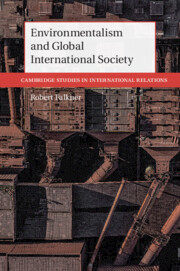Book contents
- Environmentalism and Global International Society
- Cambridge Studies in International Relations: 156
- Environmentalism and Global International Society
- Copyright page
- Dedication
- Contents
- Acknowledgements
- Abbreviations
- 1 Introduction
- Part I Theory
- Part II History
- 4 The Origins of Global Environmentalism
- 5 The Emergence of Environmental Stewardship as a Primary Institution
- 6 The Globalisation of Environmental Stewardship
- 7 Environmental Stewardship between Consolidation and Contestation
- Part III Analytical Perspectives
- Part IV Conclusions
- References
- Index
- Cambridge Studies in International Relations
5 - The Emergence of Environmental Stewardship as a Primary Institution
from Part II - History
Published online by Cambridge University Press: 03 August 2021
- Environmentalism and Global International Society
- Cambridge Studies in International Relations: 156
- Environmentalism and Global International Society
- Copyright page
- Dedication
- Contents
- Acknowledgements
- Abbreviations
- 1 Introduction
- Part I Theory
- Part II History
- 4 The Origins of Global Environmentalism
- 5 The Emergence of Environmental Stewardship as a Primary Institution
- 6 The Globalisation of Environmental Stewardship
- 7 Environmental Stewardship between Consolidation and Contestation
- Part III Analytical Perspectives
- Part IV Conclusions
- References
- Index
- Cambridge Studies in International Relations
Summary
Chapter 5 examines the rebuilding of the global environmental movement after the Second World War. Environmental protection did not become one of the core objectives of the newly created United Nations. It was not until the ‘environmental revolution’ of the 1960s, which transformed environmentalism from an elite concern into a mass movement with wider electoral consequences for governments, that international society began to accept environmental stewardship as a new primary institution. Within a short space of time, from the mid-1960s until the early 1970s, leading industrialised economies established environmental protection first as a comprehensive domestic duty of the state and then as a general responsibility for international society. The 1972 Stockholm conference, the first UN conference on the environment, became the equivalent of a ‘constitutional moment’ in the greening of the international normative order. This chapter traces the process through which world society actors successfully transmitted environmentalism into international society, with leading powers such as the United States providing critical leadership along the way.
Keywords
- Type
- Chapter
- Information
- Environmentalism and Global International Society , pp. 104 - 127Publisher: Cambridge University PressPrint publication year: 2021

